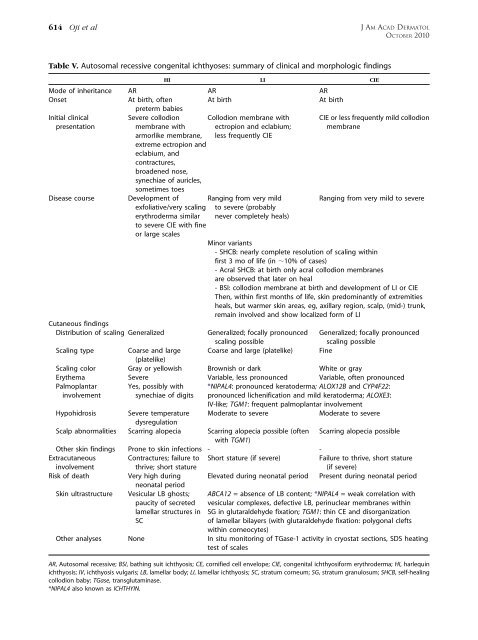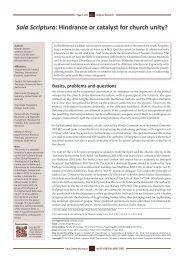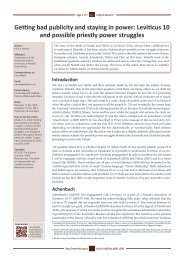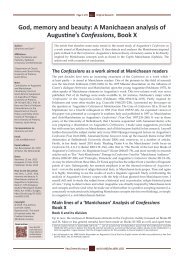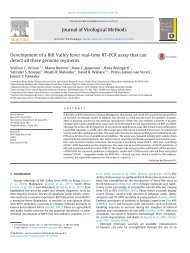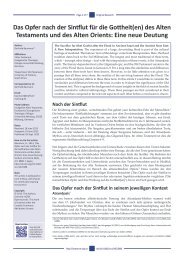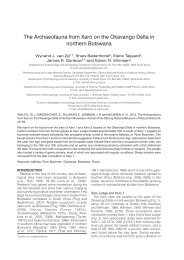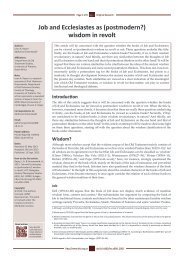Revised nomenclature and classification of inherited ichthyoses ...
Revised nomenclature and classification of inherited ichthyoses ...
Revised nomenclature and classification of inherited ichthyoses ...
Create successful ePaper yourself
Turn your PDF publications into a flip-book with our unique Google optimized e-Paper software.
614 Oji et al<br />
Table V. Autosomal recessive congenital <strong>ichthyoses</strong>: summary <strong>of</strong> clinical <strong>and</strong> morphologic findings<br />
JAM ACAD DERMATOL<br />
OCTOBER 2010<br />
HI LI CIE<br />
Mode <strong>of</strong> inheritance AR AR AR<br />
Onset At birth, <strong>of</strong>ten<br />
preterm babies<br />
At birth At birth<br />
Initial clinical<br />
Severe collodion Collodion membrane with CIE or less frequently mild collodion<br />
presentation<br />
membrane with ectropion <strong>and</strong> eclabium; membrane<br />
armorlike membrane,<br />
extreme ectropion <strong>and</strong><br />
eclabium, <strong>and</strong><br />
contractures,<br />
broadened nose,<br />
synechiae <strong>of</strong> auricles,<br />
sometimes toes<br />
less frequently CIE<br />
Disease course Development <strong>of</strong> Ranging from very mild<br />
Ranging from very mild to severe<br />
exfoliative/very scaling to severe (probably<br />
erythroderma similar<br />
to severe CIE with fine<br />
or large scales<br />
never completely heals)<br />
Minor variants<br />
- SHCB: nearly complete resolution <strong>of</strong> scaling within<br />
first 3 mo <strong>of</strong> life (in ;10% <strong>of</strong> cases)<br />
- Acral SHCB: at birth only acral collodion membranes<br />
are observed that later on heal<br />
- BSI: collodion membrane at birth <strong>and</strong> development <strong>of</strong> LI or CIE<br />
Then, within first months <strong>of</strong> life, skin predominantly <strong>of</strong> extremities<br />
heals, but warmer skin areas, eg, axillary region, scalp, (mid-) trunk,<br />
remain involved <strong>and</strong> show localized form <strong>of</strong> LI<br />
Cutaneous findings<br />
Distribution <strong>of</strong> scaling Generalized Generalized; focally pronounced Generalized; focally pronounced<br />
scaling possible<br />
scaling possible<br />
Scaling type Coarse <strong>and</strong> large<br />
(platelike)<br />
Coarse <strong>and</strong> large (platelike) Fine<br />
Scaling color Gray or yellowish Brownish or dark White or gray<br />
Erythema Severe Variable, less pronounced Variable, <strong>of</strong>ten pronounced<br />
Palmoplantar Yes, possibly with *NIPAL4: pronounced keratoderma; ALOX12B <strong>and</strong> CYP4F22:<br />
involvement synechiae <strong>of</strong> digits pronounced lichenification <strong>and</strong> mild keratoderma; ALOXE3:<br />
IV-like; TGM1: frequent palmoplantar involvement<br />
Hypohidrosis Severe temperature<br />
dysregulation<br />
Moderate to severe Moderate to severe<br />
Scalp abnormalities Scarring alopecia Scarring alopecia possible (<strong>of</strong>ten<br />
with TGM1)<br />
Scarring alopecia possible<br />
Other skin findings Prone to skin infections - -<br />
Extracutaneous Contractures; failure to Short stature (if severe) Failure to thrive, short stature<br />
involvement<br />
thrive; short stature<br />
(if severe)<br />
Risk <strong>of</strong> death Very high during<br />
neonatal period<br />
Elevated during neonatal period Present during neonatal period<br />
Skin ultrastructure Vesicular LB ghosts; ABCA12 = absence <strong>of</strong> LB content; *NIPAL4 = weak correlation with<br />
paucity <strong>of</strong> secreted vesicular complexes, defective LB, perinuclear membranes within<br />
lamellar structures in SG in glutaraldehyde fixation; TGM1: thin CE <strong>and</strong> disorganization<br />
SC<br />
<strong>of</strong> lamellar bilayers (with glutaraldehyde fixation: polygonal clefts<br />
within corneocytes)<br />
Other analyses None In situ monitoring <strong>of</strong> TGase-1 activity in cryostat sections, SDS heating<br />
test <strong>of</strong> scales<br />
AR, Autosomal recessive; BSI, bathing suit ichthyosis; CE, cornified cell envelope; CIE, congenital ichthyosiform erythroderma; HI, harlequin<br />
ichthyosis; IV, ichthyosis vulgaris; LB, lamellar body; LI, lamellar ichthyosis; SC, stratum corneum; SG, stratum granulosum; SHCB, self-healing<br />
collodion baby; TGase, transglutaminase.<br />
*NIPAL4 also known as ICHTHYIN.


